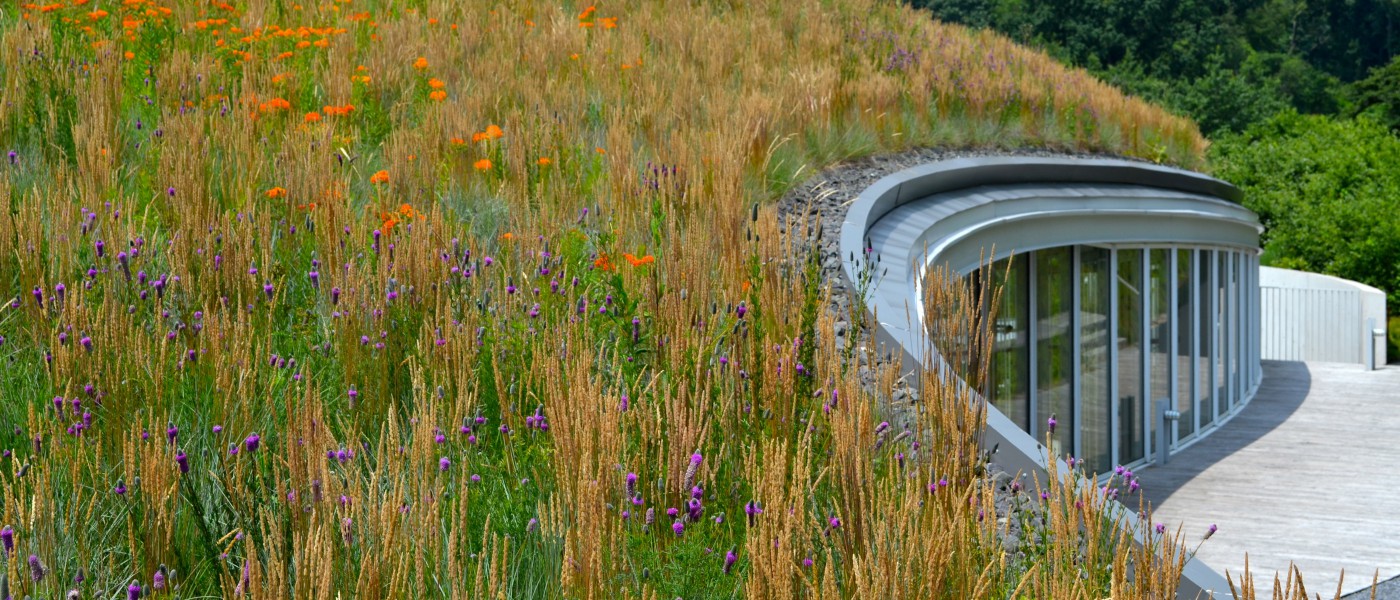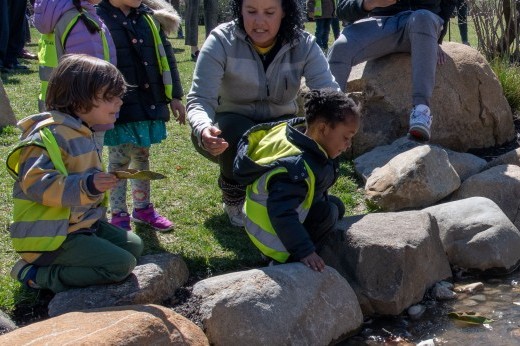Next time you’re near the Garden’s Diane H. and Joseph S. Steinberg Visitor Center, look up! A 9,600-square-foot green roof meadow thrives atop the building, with a palette of over 28,000 plants including four species of grasses and four perennial wildflowers, all native to North America. Planted in dramatic sweeps across the roof, this simple yet dynamic palette evokes a midwestern prairie and offers a lively progression of color and texture throughout the seasons.
This beautiful rooftop planting isn’t just for looks, though. Living roofs like this one have a host of benefits, including improved stormwater management, added wildlife habitat, lower energy needs and associated costs, reduced noise levels, lower levels of greenhouse gas emissions, improved air quality, and reduced urban heat island effect. Being on display at a botanic garden also provides opportunities for climate education.
The Visitor Center itself and the three-acre site that surrounds it feature several other green building elements, too. The curved building nestles into the adjacent hillside gardens and has earned LEED (Leadership in Energy and Environmental Design) Gold certification from the United States Green Building Council.
Included features of the green design are 28 geothermal wells for energy-efficient heating and cooling, reclaimed building materials, earth-sheltered construction that insulates the north-facing wall, and floor-to-ceiling windows that face south to soak in the light and heat of the winter sun.
Most green building projects, including this one, are designed to help sustainably manage stormwater runoff, a major source of water pollution when sudden, heavy rains overburden combined sewer systems. This is accomplished through not only the green roof, but also several sunken rain gardens, or bioswales, and a stormwater channel running midway through the site.
Together, they mimic nature to collect, filter, and absorb stormwater runoff from the surrounding gardens and pavement. During major storms, overflow from the green roof and adjacent spaces is directed to the bioswales. Overflow from those is directed to the pond in the Japanese Hill-and-Pond Garden and then circulates through the rest of the Garden’s Water Conservation Project system. These green infrastructure elements were a natural fit for the Garden to showcase the essential role plants have not only in recycling water, but also in supporting wildlife, filtering the air, and moderating temperature through a process called evapotranspiration.
Opened in 2012, the Visitor Center site was designed by architecture firm Weiss/Manfredi and the landscape was designed by HM White Site Architects. The green roof system was designed by SIKA Sarnafil in partnership with landscape architecture firms Roofmeadow and New York Green Roofs.
Our prairie-style living roof is considered a semi-intensive system, one of several roof types based on the depth of the soil. Extensive green roofs are the shallowest, with a depth of two to five inches. These support small, shallow-rooted, drought-resistant plants such as sedum. They’re usually cheaper to install, lighter in weight, and require less irrigation and maintenance than other living roofs, but do not support much plant or visual diversity.
At the other end of the spectrum are intensive green roof systems with soil depths of eight to 30 or more inches, which can incorporate trees and large shrubs. These are the most expensive, but they support the widest variety of plants and can support garden-like spaces for humans and habitat for wildlife.
Semi-intensive systems like ours fall in between with a soil depth of five to eight inches. These support not only sedums, but also grasses, wildflowers, and sometimes small shrubs. They require irrigation and maintenance, and offer plenty of visual interest and biological diversity. It was a good choice for a botanic garden display since it’s not only practical, but also educational and beautiful.
As the gardener and curator of the Visitor Center gardens, I work with a small team from New York Green Roofs to maintain the planting. While on the sloped roof, we each wear a fall arrest harness with a shock-absorbing lanyard that clips into a cable running along the spine of the roof. Weeding takes up the bulk of our time, but we also check on the irrigation system, monitor for pests, inspect the drains and weatherproofing elements, take soil samples to assess nutrient levels, apply soil amendments as needed, and take notes and photographs for monthly reports. I climb up to check on, troubleshoot, and plan work on the roof in between these team maintenance visits.
The lightweight, porous growing media supports eight perennial prairie species native to the eastern and midwestern United States. The four grasses growing on the roof are June grass (Koeleria macrantha), prairie dropseed (Sporobolus heterolepis), little bluestem (Schizachyrium scoparium ‘The Blues’), and sideoats grama (Bouteloua curtipendula). There are also four wildflowers—butterfly weed (Asclepias tuberosa), purple prairie clover (Dalea purpurea), dwarf blazing star (Liatris microcephala), and beardtongue (Penstemon hirsutus).
These native midwestern prairie plants have some drought tolerance and preference for full sun and well-drained soils when growing in their natural environment. Of course, a green roof is by no means a natural environment for these plants to live–in some ways it is a very large, shallow container planting.
Most of the plants on the roof have roots that would extend five to 15 feet into the soil in their native habitat. On the roof they are living in only six inches of growing media and cannot tap into reserves of moisture deeper in the soil profile during the growing season. To help, a specialized, sub-surface drip-irrigation system goes off up to several times a day.
This irrigation system is unique and incorporates base capillary irrigation, a form of sub-irrigation. Drip irrigation lines sit on top of a capillary mat that extends across the entire roof at the bottom of the soil profile. The lines regularly deliver water to keep the mat consistently moist; the water rises through the soil profile via capillary action, keeping the media moist and the plants watered.
Every November, the system is drained, blown dry with compressed air, and shut off for the winter. The entire roof gets a haircut in late March or early April once the snow has melted, and the irrigation system is turned on again.
The green roof planting provides a beautiful and dynamic show of evolving color and texture throughout the seasons. Late summer or early fall is a great time to see the warm-season grasses in their full height and glory. For example, clump-forming prairie dropseed, native to tallgrass and mixed prairies of the central U.S., forms fine-textured green mounds with delicate panicle flowers that rise above, almost dancing in the wind. These slender blooms have a unique scent reminiscent of cilantro. Some people love it, some people hate it. When planted in a mass, prairie dropseed makes a lovely undulating, green, fine-textured groundcover. It also provides good color and texture, as well as seeds and nest-building material for birds in fall and winter.
The roof meadow attracts a variety of insects as well. In summer, flowering plants attract bees and butterflies, including monarch (Danaus plexippus) and pearl crescent (Phyciodes tharos) butterflies. The monarchs lay their eggs on milkweed leaves and the caterpillars feed on this normally toxic plant.
Clusters of the diminutive, rusty-orange eastern amberwing dragonflies (Perithemis tenera) also rove the rooftop meadow all summer hunting for mosquitoes and other small insects. When I see them, I’m reminded that dragonfly fossils date back more than 300 million years. Some of the first winged insects to evolve, they’ve long appeared as symbols in cultures around the world and represent adaptability, transformation, opportunity, insight, self-realization, and finding light in darkness.
So next time you’re at the Garden, look up—you may smell cilantro and see a dragonfly dart by, urging you to live in moment, refresh your energy, and bravely forge on with an open heart and mind.



